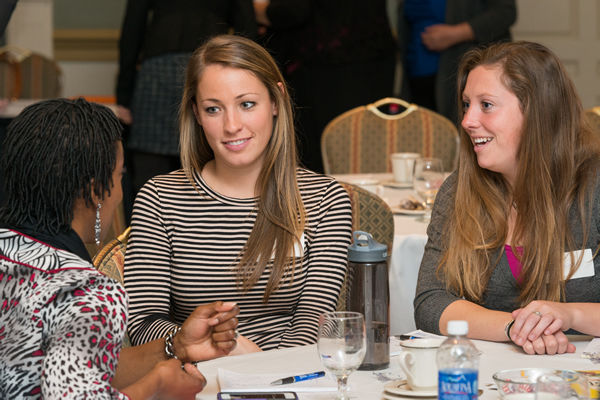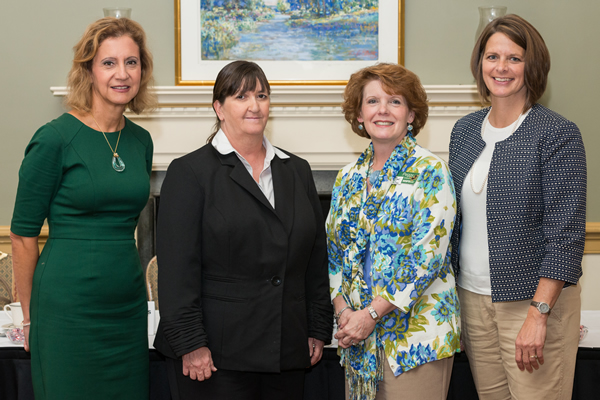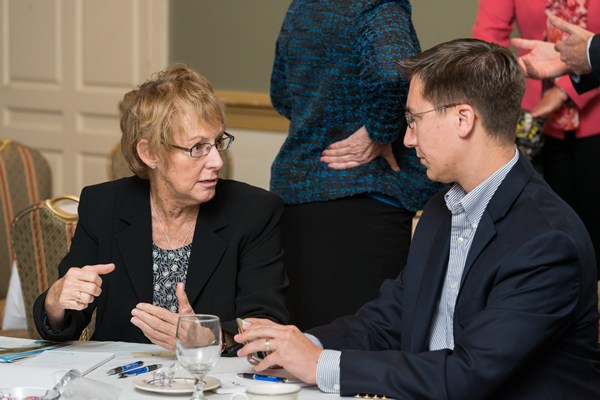


Employee development
Roundtable provides insights into the multigenerational workforce
1:53 p.m., Nov. 27, 2013--From traditionalists and baby boomers to generations X, Y and Z, the current American workforce is characterized by a huge and unprecedented age range, due in large part to the number of workers waiting longer and longer to retire.
The challenges and opportunities of leading a multigenerational workforce was the topic of last month’s Employee Development Roundtable, the ninth such forum sponsored by the University of Delaware’s Division of Professional and Continuing Studies.
Campus Stories
From graduates, faculty
Doctoral hooding
The event brings together professionals from area businesses and organizations, along with UD faculty and staff, to network and share their expertise around a timely topic relating to organizational development and human resources.
A panel representing some of Delaware’s top human resources experts, executives and practitioners led the discussion and included Peggy Eddens, chief human capital officer for WSFS bank; Barbara McCleary, statewide training and organizational development administrator for the state of Delaware; Bernadette Racicot, assistant professor of management in UD’s Alfred Lerner College of Business and Economics; and Bahira Sherif Trask, professor and associate chair of UD’s Department of Human Development and Family Studies.
To begin the conversation, the audience was asked to list some of the challenges and benefits they have encountered in leading a multigenerational workforce.
Many cited the benefits of having both younger and older employees in the workplace, bringing with them a diversity of ideas and thought, and allowing opportunities for mentoring and creative exchange. Younger team members were often credited with innovative thinking, a high comfort level with technology, collaborative attitudes and an entrepreneurial spirit. Older employees were credited with professional mastery in their field and a great depth of practical experience.
But participants also noted challenging variations in learning and communication styles, attitudes toward change and perceptions of what it means to have a good work-life balance.
In response, the panelists shared a wide range of insights and strategies from their research and experiences:
- Focus on shared values. “We continually survey our employees about their core attitudes toward their work and toward the organization, and we found that there very few age differences in key work-related values,” said Eddens. “We learned that no matter what their age, everyone has those fundamental desires of wanting to contribute their best, wanting to grow, and wanting their opinion to count. We have to build our organizational culture around those shared values.”
- Promote mentoring. The wide age range in the workplace brings with it a broad range of expertise and experience, often in completely different areas. Said Eddens, “Allowing mentoring to take place within your work culture is an opportunity for one generation to lead the other in their areas of strength, with an exchange that’s needed by both, whether it’s help with synching your smartphone, or passing along the benefit of professional wisdom or expertise.”
- Don’t stereotype. All the panelists agreed that generational age is not necessarily the most important characteristic defining an individual’s perspective toward work. Other important factors include gender, economic status and whether an employee has children. Trask also pointed to the realities surrounding economic globalization as a significant determinant in the career experiences of younger and older generations, not related to their age at all. “Globalization and outsourcing have dramatically affected our experiences in the workplace, with lifetime company jobs being the experience of a past generation,” noted Trask. “That has a big impact on the mindset of the newer work generations, who have had very different experiences relating to job security and company loyalty.”
- Create and effectively manage diverse teams. “Where we see dysfunction in an organization, it usually comes down to a lack of trust, whether we’re talking about age differences, or gender, or any other type of diversity in the workforce,” observed McCleary. “It is our challenge to bring people together, capitalizing on their strengths, and this can happen through teams, when people are working together on a common goal.” Racicot added, “We know that we can have greater creativity and productivity when we have diverse teams, but we’ve also seen that when you first put a diverse team together, you can get an initial reduction in performance, because of conflict on those teams. A good leader needs the skills to manage conflict so that teams can focus on the tasks at hand.”
- Find the right motivators. There can be a perception on the part of older generations that younger workers “don’t want to work hard,” whereas in reality they may be acting on a desire to create a better work-life balance than their parents’ generation, who they witnessed working lots of overtime, sometimes demonstrating more commitment to work than to family. The way to foster that level of commitment in a multigenerational workplace, says Eddens, is to discover the relevant motivators that will harness the passions of every individual. “And we can do that without pigeonholing or stereotyping people,” she added. “Those motivators may be the opportunity to be creative, or the ability to work independently, or the opportunity to be involved in issues that they care about.”
As with previous Roundtables, the subject matter of this panel discussion was suggested by the Employee Development Advisory Committee, which is made up of human resources leaders and executives from the region who offer input to UD’s Division of Professional and Continuing Studies on current trends and topics in human resources development.
“The Roundtable is a great way for us to learn from one another, and from both practitioners and academicians in the field,” said Jim Broomall, associate provost for professional and continuing studies. “The advisory committee has been invaluable in highlighting for us the issues that keep HR and business professionals up at night, issues toward which we can help apply the University’s resources and knowledge, given a forum like this.”
The Oct. 18 event was cosponsored by the UD Career Services Center and the Alfred Lerner College of Business and Economics, and was held at the Goodstay Center on the University’s Wilmington Campus.
For more information about the Employee Development Roundtable, including previous topics addressed, visit this website.
Article by Nora Riehl Zelluk
Photos by Evan Krape










